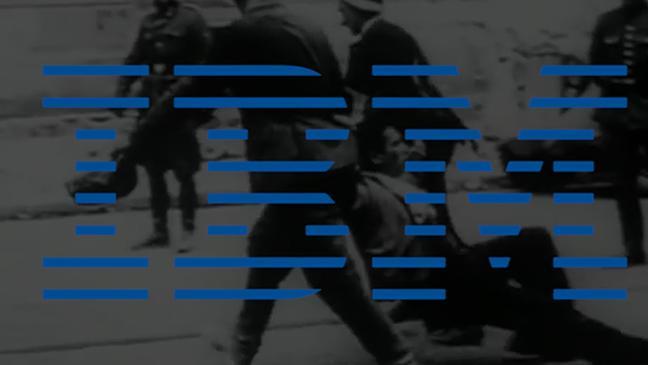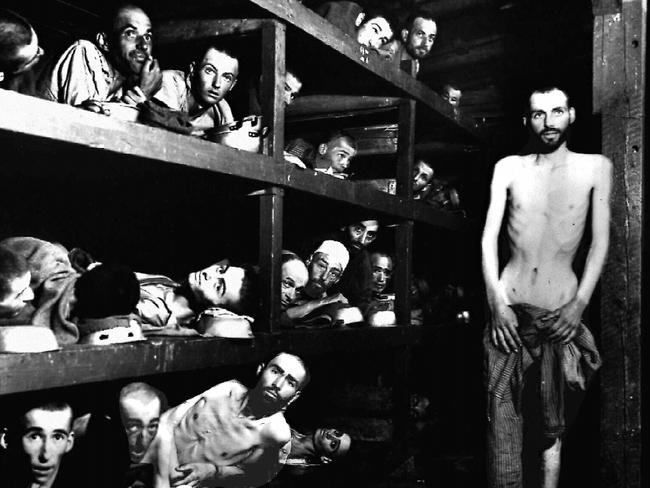‘Traitors’ book extract: IBM’s secret Nazi past
BEFORE computers were invented, some of the first machines IBM made were used for the most awful crimes the world has ever seen.

Companies
Don't miss out on the headlines from Companies. Followed categories will be added to My News.
TODAY, IBM (International Business Machines) is a massive New York based multinational technology corporation with operations around the world.
It has annual revenue of $US81 billion and 380,000 employees. Finance magazines Barron’s and Fortune dub IBM the world’s most respected and admired company.
However, the huge corporation has a dark, secret past it doesn’t tell you about in its glossy brochures listing Nobel prize winners and technological breakthroughs.
What they don’t tell you is that in the 1930s IBM was instrumental in providing groundbreaking technology that assisted the Nazi regime in identifying and tracking down Jews for its methodical program of genocide.
One of the machines is displayed in a place of prominence at the United States Holocaust Memorial Museum in Washington DC. The IBM badge can be clearly seen.

It was a technical marvel of its time, the forerunner of today’s computers. The complex-looking machine was a punch card and card-sorting system initially built to assist the collation of vast amounts of information gathered in a census.
In the 1930s, IBM was one of the largest firms in the world, a true multinational conglomerate, with its headquarters in New York.
Oddly, IBM has Germanic origins. Herman Hollerith was the son of German immigrants. Working in the US Census Bureau, he was still in his twenties when he devised a machine using punch cards to tabulate the 1890 census.
A smart businessman, he didn’t sell the machines or the punch cards but only leased them to whoever needed work done. It was a formula that kept the money rolling in.
His machines were used in censuses around the world, as well as for major operations such as railways and shipping.
Hollerith set up a subsidiary in Germany called Deutsche Hollerith Maschinen Gesellschaft — Dehomag for short — and assigned it all of his patents. In 1911 Hollerith sold his firm to financier Charles Flint, who put tough and ambitious salesman Thomas Watson in charge. The name was changed to International Business Machines, IBM for short, and the company grew and grew.
In 1924 IBM owned eighty-four per cent of Dehomag, and the firm’s New York headquarters kept a close eye on all that its German subsidiary did throughout the war.
American investigative author Edwin Black was deeply shocked when he saw the IBM — Dehomag machine in Washington’s Holocaust Museum. The museum said on the display that IBM was responsible for organising the German census of 1933, which for the first time identified all Jews in the German population.
Black was mystified how an iconic American corporation could be involved in the Holocaust, the most evil act of the twentieth century. He then spent decades digging up the links between IBM America and the Nazi genocide of millions of Jews and other inmates of the concentration camps.
He said IBM tried to block his access to the firm’s records at every turn. But from archives around the world, and some files from IBM, he managed to assemble 20,000 documents that revealed IBM’s horrific role in the war, and in 2001 Black published his groundbreaking findings in IBM and the Holocaust.
It was shocking. Black wrote that IBM headquarters in New York knew all about its German subsidiary designing and supplying indispensable technological equipment that allowed the Nazis to achieve what had never been done before — “the automation of human destruction”.
Buried deep in the files of the IBM company and German archives, Black alleged he discovered IBM boss Thomas Watson was an enthusiastic supporter of the Nazis from the very early years of the rise of Hitler.
“IBM NY always understood from the outset in 1933 that it was courting and doing business with the upper echelon of the Nazi Party,” Black wrote.
Watson was obsequious in pandering to the Nazi hierarchy, writing a grovelling letter in 1937 to Nazi Economics Minister Hjalmer Schacht declaring that the world must extend “a sympathetic understanding to the German people and their aims under the leadership of Adolf Hitler”.
To show his gratitude to Watson and the support of IBM, Hitler personally bestowed on Watson a special swastika-bedecked medal to honour his unique service to the Reich — the Order of the German Eagle with Star.
Black writes that in June 1940 Watson was forced to return the medal after public outrage that such a prominent American business leader would be in possession of a Nazi medal while Nazi troops occupied Paris.
Black found documents showing that Watson encouraged the IBM German subsidiary to build and supply 2000 of the card punch machines to Nazi Germany and thousands more in nations that the Nazis conquered.
From the moment Hitler came to power in 1933, IBM used its monopoly on punch card technology to “organise, systemise and accelerate Hitler’s anti-Jewish program, step by step facilitating the tightening noose”.
After years of investigating IBM’s connections to the Nazis and the Third Reich, Black is in no doubt that “Thomas Watson and his corporate behemoth were guilty of genocide”.
Black concludes that for Watson and IBM, trading with the monster of Nazi Germany wasn’t about anti-Semitism or National Socialism. “It was always about the money.’”
Machines belonging to IBM’s subsidiary Dehomag were set up in every concentration camp.
IBM’s custom-made punch cards from the camps sorted inmates by religion, nationality, sexual orientation, family history and political leaning. Each camp had its own number on the cards. Auschwitz was 001, Buchenwald 002, Dachau 003, and so on. It then showed each prisoner’s classification. An 8 designated a Jew, homosexuals were 3, “anti-socials” (which meant political prisoners) were 9, Gypsies were 12.
The manner of death in the camps was recorded by its own number — 4 was execution, 5 was suicide, 6 was the gas chamber, 3 was death by natural causes such as starvation or disease.

Black said documents released by the German archives show that staff from IBM’s German subsidiary had to create codes to differentiate between a Jew who had been worked to death and one who had been gassed. The machines methodically recorded the fate of every prisoner.
Every two weeks, staff from IBM’s German subsidiary visited the camps to service the machines, deliver new blank cards, print and collate the punched cards, and reconfigure the machines if any change in information was requested by the SS or Gestapo.
Black found documents showing that IBM’s German subsidiary built a reinforced-concrete bombproof blockhouse to protect its twelve valuable machines at Dachau.
“IBM equipment was among the Reich’s most important weapons, not only for its war against the Jews, but in its general military campaigns and control of railway traffic,” wrote Black.
“Watson personally approved expenditures to add bomb shelters to Dehomag installations because the cost was borne by the company. Such costs cut into IBM’s profit margin. Watson’s approval was required because he received a one per cent commission on all Nazi business profits.”
As the Third Reich expanded across Europe, IBM’s subsidiaries in the Netherlands, Poland, France and other conquered nations supplied machines to aid the Nazi genocide of Jews, Gypsies, homosexuals and other peoples.
Since the machines were leased, not sold, the Nazi regime had to keep on paying for them throughout the Holocaust years. The profits were enormous. Invoices for every machine and punch card went from the Third Reich subsidiaries to the IBM office in Geneva, and then on to headquarters in New York.
In May 1941 the Geneva office reported to Watson in New York that Dehomag was cutting the price of its rented machines for the Nazis by ten per cent. “This would mean a reduction of approximately 1,500,000 Reichsmarks in the gross annual production of the company.”
As Nazi Germany advanced across Europe in 1939, 1940 and 1941, pressure mounted on the United States to stop sitting on the sidelines and join Britain, the Commonwealth and the Soviet Union in fighting the Nazi evil.
Nazi atrocities received coverage in the American press, but that didn’t stop IBM from keeping its business going with the Nazis. IBM’s communications with its subsidiaries in Nazi-controlled Europe became difficult, but Black found documents indicating that the US State Department had been extremely helpful behind the scenes.
In January 1941, Watson wrote to the assistant chief of the US State Department’s European Affairs division thanking him for passing on letters to an IBM salesman in Berlin. US embassies in Nazi-occupied lands were also helpful in passing on messages to IBM salesmen busy setting up subsidiaries to do business with the new Nazi occupiers.
In September 1941, war with Germany seemed inevitable for the Americans. President Franklin D Roosevelt banned trade with the Nazi regime unless the government issued a special permit for each transaction.
IBM had to tell its subsidiaries that from now on they would have to operate on their own. Watson did not order IBM’s German subsidiary to stop supplying machines to the Nazis. On the contrary. Watson expected them to keep making money for the IBM empire even though, after December 1941 when war was declared, they were the enemy.
In war, Watson saw yet another business opportunity. Through a new US subsidiary, Munitions Manufacturing Corporation, Watson quickly converted a large slice of IBM’s US production capacity to making weapons — 20-millimetre anti-aircraft cannon, Browning automatic rifles, bomb sights, M1 carbine rifles — all stamped with the IBM logo.
The punch card machine also proved profitable on home ground. If a US official wanted to know where a particular soldier or sailor was, an IBM machine could pinpoint his location anywhere in the world.

The day after the attack on Pearl Harbor, IBM machines were used to locate every person of Japanese origin in the United States for internment. IBM punch cards identified every American by race.
The company also developed code-breaking machines. “It was an irony of the war that IBM equipment was used to encode and decode for both sides of the conflict,” Black wrote.
War was good for IBM. Ninety days after Pearl Harbor, an excited Watson told the press that IBM had secured $150 million in defence contracts. IBM’s total wartime sales and rentals grew from $46 million in 1940 to $140 million a year by 1945.
Watson cloaked himself in the US flag and embarked on an expensive public relations campaign to put himself and IBM at the forefront of patriotism and the US war effort. He proclaimed IBM only made one per cent profit from the sale of military equipment it made for the US government.
Democrats asked Watson to run for Governor of New York. He declined.
In 1943, however, the Economic Warfare Section of the US Justice Department, the unit responsible for investigating cases of trading with the enemy, looked into IBM’s deals with Nazi Germany. It didn’t like what it saw.
The unit’s chief investigator, Howard J Carter, wrote a memo to his superiors warning that corporations like IBM had become larger and more powerful than nations. Carter was denied access to crucial files by IBM that could have proved how closely it was linked to the Nazi regime.
In reality, there was nothing Carter could do to challenge IBM. The company was simply too big and too essential to the US war machine.
As Allied troops rolled back the German army in 1944 and 1945, IBM officials followed right behind them, anxious to secure the equipment and records of its pre-war subsidiaries. Every file and banknote recovered was sent to IBM’s Geneva office.
Dehomag emerged from the ruins of Germany relatively unscathed. “Its machines were salvaged, profits preserved and corporate value protected,” wrote Black.
With the war over, IBM was able to recapture its highly profitable German subsidiary and assimilate all the profits Dehomag had made trading with the Nazi regime.
Former IBM employee James T Senn was a US army corporal but considered himself part of the “IBM Army”, a network of former IBM employees in the military services who had all been promised their jobs back when the war was over.
On 26 April 1945, Senn wrote to Watson that he had just visited the Dehomag firm in Sindelfingen, 644 kilometres southwest of Berlin. Senn said he and his captain — another member of the IBM Army — were the first Americans to set foot in the plant since the war and that they had been greeted by Dehomag employees.
“The entire factory is intact, spared for some unknown reason by our airmen ... every tool, every machine is well preserved and ready to start work at a moment’s notice ... a card stock of over a million cards is ready for shipment,” an excited Senn wrote to his old boss. Senn concluded by saying that Dehomag managers Herr Haug and Herr Wiesinger “would like to be remembered to you”.

Edwin Black reports that IBM files from 1945 contain many such letters. One IBM Army officer, Lieutenant Colonel Lawrence Flick, proudly told Watson how he tried to assist Dehomag managers who had been detained or arrested by the Allies and get them back to work for IBM.
Watson was furious. He didn’t want the German managers restored to their positions; he had other plans, and told the top army brass to tell Flick to stop interfering. The Pentagon acted swiftly, promptly retiring Flick and sending him back to the US.
IBM immediately took back control of the rest of its European subsidiaries and demanded the profits they had made during the war. In this demand IBM had the assistance of the US government, who was keen on IBM getting back its machines because they were needed to run the military occupation of post-war Germany.
When it came time to put German industrialists and Nazi leaders on trial, it was IBM machines that stored and collated the evidence and translations. While many German war profiteer corporations, such as the mammoth IG Farben, were stripped for war reparations, Dehomag was untouched.
By 1949 the German subsidiary was 100 per cent owned by IBM New York and the name was changed to IBM Germany. Dehomag was gone. Nobody questioned the role of the IBM machine and its Dehomag subsidiary in the Nazi death camps or the Nazi war machine.
In the ruins of post-war Europe, IBM was back in business big time. Allied military administrations turned to IBM to compile statistics on post-war Germany. Wartime Dehomag managers were employed in IBM Germany to do the job.
They never faced justice for their involvement in the automation and information collating that enabled the Nazis to carry out mass genocide.
Thomas Watson retired an extremely wealthy man in 1956, aged 82. He was a respected businessman and generous philanthropist who helped set up Binghamton University and served as trustee of Columbia University.
He died five weeks after retiring. His eldest son, Thomas Watson Junior, took over his position as chief executive officer of IBM. He died in 1981. Another son, Arthur, was president of IBM World Trade Corporation. He died in 1974.
On the publication of Edwin Black’s book in 2001 about IBM and its link to the Holocaust, IBM released a statement acknowledging that IBM equipment supplied by Dehomag had been used by the Nazi government. But IBM insisted that during the war Dehomag and hundreds of other foreign-owned companies came under the control of Nazi authorities.
The IBM statement said most records concerning Dehomag were lost or destroyed during the war, but documents that did exist had been placed on the public record to assist research and historical scholarship.
“IBM and its employees around the world find the atrocities committed by the Nazi regime abhorrent and categorically condemn any actions which aided their unspeakable acts,” it said.
In a 2002 statement, IBM denied assertions by Black that the company was withholding documents and material from the wartime era.
This is an extract from Traitors, by Frank Walker, published by Hachette and available now.
Originally published as ‘Traitors’ book extract: IBM’s secret Nazi past


